 |
| Category: Army
Today/State Regts |

|
This is a sub category index |
|
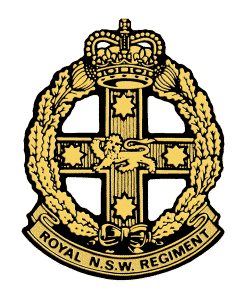
For
other badges of the Regiment 
Primus
in Terra Australis First In
Australia |
The Royal New South
Wales Regiment |
| <<
The
badge worn by the Regiment is basically that worn by the New South Wales
Military Forces from about 1885 to 1903.
This was in it's turn adopted
from the badge of the Colony of NSW of 1876.
The principal elements are the Crown
indicating a Royal Regiment, the Cross of St George bearing the Lion of
England and the stars of the Southern Cross, the whole being enclosed
within a wreath of Waratahs, the floral emblem of NSW. |
Sub category index
|
|

|
| Possibly
Sydney c.
1890-1895. E Company, 2nd NSW Infantry Regiment wearing
the khaki uniform introduced in NSW in 1890. Units are distinguished by coloured
shoulder straps and metal
regimental badges. (one Sergeant wears a
different puggaree which suggests he is from another Regiment). The
figure on far left is evidently an officer (possibly three officers in
photograph), several Sergeants and other NCOs are present. On left arm
(below elbow) some men wear good conduct chevrons and shooting awards.
This style of uniform changed after 1894 and the type of hat badge
evident was changed in 1897. The figure 3rd from left standing is Cecil
Byron Vidler who later saw service in the Boer War as a Trooper in the
2nd NSW Mounted Rifles. |
|
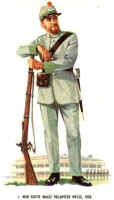
|
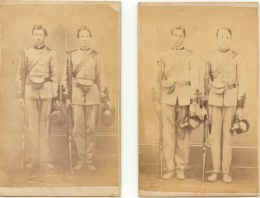
|
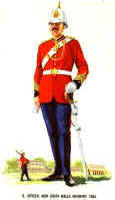
|
|
Private, New South Wales
Volunteer Rifles, 1855
|
1st NSW Rifle
Volunteers Two
old photographs dated somewhere in the 1860's or 1870's.The family
name of the men could be Appeldore or Stone. They lived at Penrith
at the time. photo: Kathy Luck |
Officer, New South Wales
Infantry, 1885
|
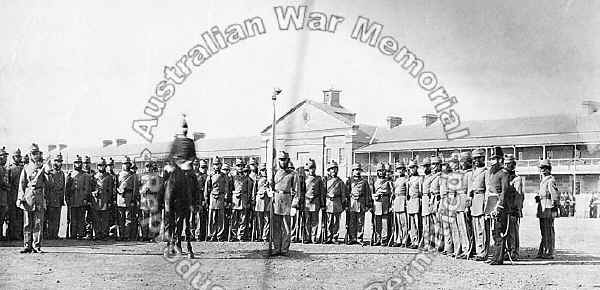 |
| Sydney, NSW.
24 May 1861.
A group of volunteer soldiers of the 1st
Regiment New South Wales Rifle Volunteers,
also known as the Sydney Battalion,
formed up in a hollow square on the Victoria Barracks parade ground. The
soldiers are all wearing uniforms of Melton Stone
Grey Cloth and Infantry Shako's
(hats). The colour of the facings on the sleeves of the jackets
identified individual companies. The soldiers are holding the Enfield
Pattern 1853 rifle, Third Model, with the Pattern 1853 socket bayonet
fitted to the rifle. Inside the hollow square the officer on the left is
holding his sword, an 1827 Pattern Rifle Officers Sword which has been
drawn from the scabbard. The mounted officer, who is obscured as his
horse has moved, is probably the Commanding Officer Major Thomas W.
Wingate, and the officer on the right is holding the Regiment's
new Colours. The colours were
presented to the Regiment by Lady Young, the wife of the newly appointed
Governor of NSW, on 18 May 1961, five days before this photograph was
taken. The soldier on the end of the right hand arm of the hollow square
is a Sergeant Major in the British regular Army, he is wearing a red
jacket over blue trousers and a British Infantry Shako. He is probably
attached to the Regiment as an instructor. Behind and to the right can
be seen a small section of British regular soldiers, possibly the 12th
Regiment of Foot.. This albumen print is signed and dated by the
photographer, "T. Wingate fecit, May 24/61". The photographer
is probably also the Commanding Officer of the Regiment, and an
acknowledged amateur photographer. |
|
Colour Patches of
parent units |
|
Colour patches were
developed and used by the Australian Imperial Force (A.I.F.) in World
War 1, as a means of rapid unit identification. In the absence of
regimental badges, they became a focal point of fierce unit loyalty and
pride.
This colour patch
system was continued throughout the Australian Army between 1921 and
1945, but ceased during the early years of the post-World War II army.
During World War II,
Australian Imperial Force unit colour patches were distinguished from
those of the non-A.I.F. component of the Australian Military Forces by
the addition of a grey border or backing. This border, or backing, was
of a shape representing the division to which the battalion was
allotted, and not necessarily symmetrical with the battalion shape, for
example 2/19th Australian Infantry Battalion's colour patch was a
half-sized battalion patch diamond-shaped brown over mid-green, within
the grey horizontal oval of the 8th Australian Division.
Likewise, the 2/13th
and 2/11th Australian Infantry Battalion colour patches were, in 1943,
with others varied in shape to the 9th Australian Division
"T"-shaped patch, their colours respectively black
superimposed on mid-green, and white superimposed on mid-green, both on
a grey backing, all colours in "T"-shape. The "T"
shape was to indicate involvement in the Siege of Tobruk.
Colour patches were
re-introduced in 1987 on a restricted scale, permitting active units
which could prove descent from a former unit which had an approved
colour patch and served either during World War 1 or World War 11, to
apply to wear the earliest version of that unit's colour patch. Policy
in the case of linked units is to wear the colour patch of the unit
taking precedence in the linked unit's designation.
Light Horse colour
patches are of a horizontal rectangle shape, divided diagonally, with
the colour of the brigade nearer the front of the wearer, the colour of
the regiment towards the rear.
Infantry
colour patches, with the exception of the 9th Australian Division, are
divided equally in the horizontal or vertical plane. In the former case,
the battalion colour is placed above the brigade colour. In the latter,
that portion of the colour patch nearer the front of the wearer is the
battalion colour, that to the rear the brigade colour. The shape of the
colour patch, with the exception of the battalions of 4th Brigade,
indicates the division to which the unit belonged in the Great War. The
4th Brigade, though wearing the 1st Division shape patch, was allotted
initially to the New Zealand and Australian Division for service at
Gallipoli. It was, after Gallipoli, allotted to 4th Division on its
being raised in Egypt in February 1916.
|
|
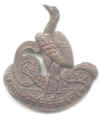
|

|
| The
6th Light Horse Regiment Badge |
The
51st Battalion Badge  |
For
other badges of the Regiment 
- 6th Australian Light Horse, later 6
NSW Mounted Rifles was converted to an Infantry Battalion by AHQ
Directive, 1 July 1956.
- 51st Battalion AIF was formed in
Egypt in 1916 by splitting off some of 11th Battalion AIF. This
Battalion Number served in NSW for a while from 1924, firstly in
it's own right as Field of Mars Regiment and later linked with 30th
Battalion as 30th/51st and later it was linked with 18th Battalion
as the 18th/51st. It was relocated to Queensland in 1936 and still
serves as 51st Bn
Far North Queensland Regiment. It is not considered as a lineage
unit of RNSWR.
|
|
Mottoes of the NSW
Infantry Units |
| Unit |
Territorial
Title |
Date |
Motto |
Meaning |
| 1 Bn |
East Sydney Regt |
1927 |
Nominis Memento |
Remember the name |
| later |
City of Sydney's Own Regt |
1939 |
Primus Agat Primas |
Let the First lead first |
| 2 Bn |
City of Newcastle Regt |
1927 |
Nulli Secundus |
Second to None |
| 3 Bn |
Werriwa Regt |
1927 |
Veteri Frondescit Honore |
It Blossoms with ancient
Honour |
| 4 Bn |
The Australian Rifles |
1927 |
For
Home & Country
|
| 13 Bn |
Maitland Regt |
1927 |
Vigor in Arduis |
Energy amid hardship |
| later |
Macquarie Regt |
1952 |
Vigor in Arduis |
Energy amid hardship |
| 17 Bn |
North Sydney Regt |
1927 |
Facta Probant |
Deeds are the proof |
| 17/18 |
North Shore Regt |
1948 |
Facta Probant |
Deeds are the proof |
| 18 Bn |
Kuring-Gai Regt |
1927 |
Legionis
Lampada Tradamus |
Let us hand on
the Legion's Lamp |
| 17/18 |
North Shore Regt |
1948 |
| 19 Bn |
South Sydney Regt |
1927 |
Fortiter et Fidetiter |
Bravely & Loyally |
| 20 Bn |
P'matta-B/Mountains Regt |
1927 |
Pro Patria |
For our Country |
| 30 Bn |
City of Sydney Regt |
1927 |
In Omni Modo Fidelis |
Loyal in every way |
| later |
NSW Scottish Regt |
1935 |
In Omni Modo Fidelis |
Loyal in every way |
| 33 Bn |
New England Regt |
1927 |
Strenue Percute |
Strike Vigorously |
| 34 Bn |
Illawarra Regt |
1927 |
Malo Mori Foedari |
I prefer to die than be
disgraced |
| 35 Bn |
Newcastle's Own Regt |
1927 |
Fifelis et Paratus |
Loyal & Ready |
| 36 Bn |
St George's English Rifle R |
1927 |
St
George for Merrie England
|
| 41 Bn |
Byron Regt |
1927 |
Mors Ante Prantum |
Death before Dishonour |
| later |
Byron Scottish Regt |
1949 |
Mors Ante Prantum |
Death before Dishonour |
| 45 Bn |
St George Regt |
1927 |
Quo Fata Vocant |
Wither Destinies Summon |
| 53 Bn |
West Sydney Regt |
1927 |
Be Prepared |
|
changed in |
1933 |
Usque Ad Finem |
Until the End |
| 54 Bn |
Lachlan-Macquarie Regt |
1927 |
Deo Patria Tibi |
For God, Country & Thee |
| 55 Bn |
NSW Irish Rifles |
1927 |
Faugh a Ballagh |
Clear the way |
| later |
NSW Rifle Regt |
1933 |
Faugh a Ballagh |
Clear the way |
|
changed in |
1937 |
Animo et Fide |
Courageously &
Faithfully |
| 56 Bn |
Riverina Regt |
1927 |
Trutina Probatus |
Proved in the balance |
| 6 LHR |
NSW Mounted Rifles |
1927 |
Toujours Pret |
Always Ready |
- Some details from A Supplement to the Handbook for
all ranks of the Royal NSW Regiment, 1994. My thanks to
- Lt Col Bell, CO, 4/3 Battalion
RNSWR and to
- Capt N Earnshaw, Adjutant, 4/3 Battalion RNSWR
and to
- Mr Alan Kitchen
|
|